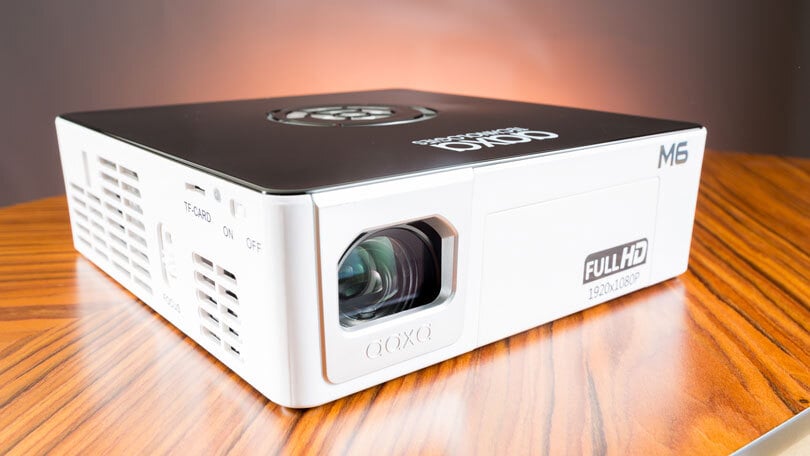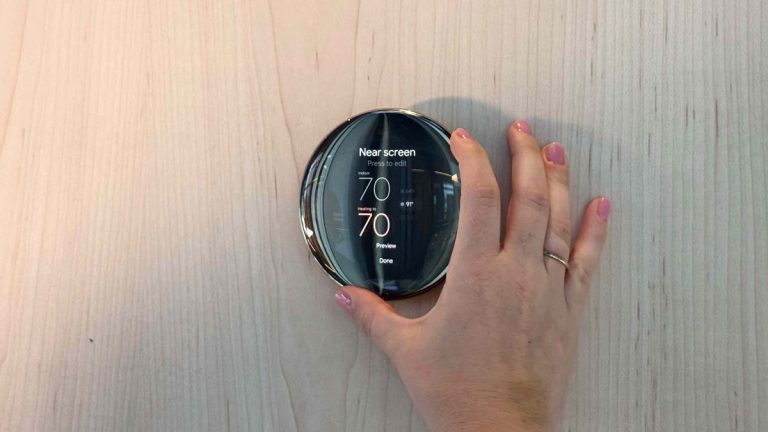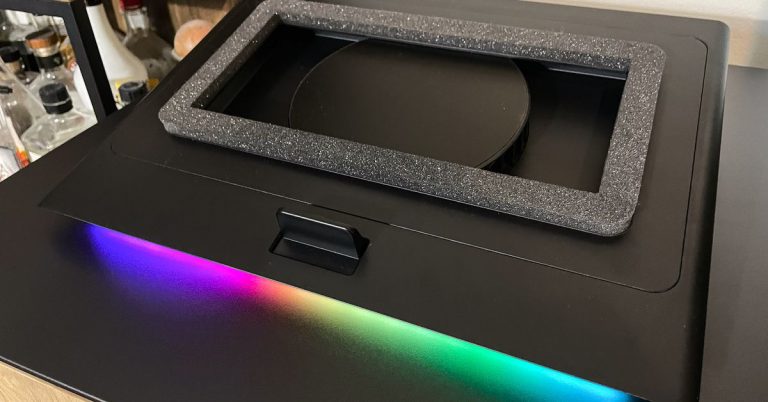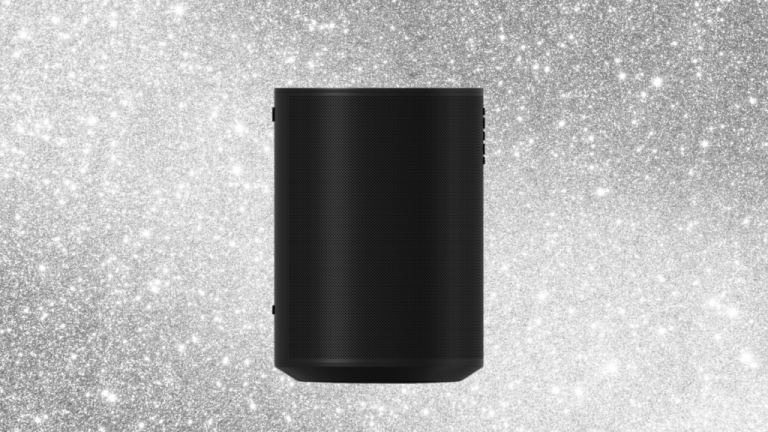The Best Portable Projectors for 2024

Deeper Dive: Our Top Tested Picks

Best Pocket/Pico Projector
Kodak Luma 75 Portable Pocket Projector
- Compact
- Built-in battery rated at 90 minutes per charge
- Unusually sure focus control
- Supports up to 1080p input resolution
- No image adjustment settings
- Low native resolution (640 by 360 pixels)
- Low 30-lumen rated brightness
Engine Type
DLP
Rated Brightness
30 ANSI lumens
Native Resolution
640 by 360
Maximum Resolution
1920 by 1080
Inputs and Interfaces
HDMI, USB
Dimensions (HWD)
0.8 by 3 by 3 inches
Weight
5 oz
Warranty
1 year
Weighing in at 5 ounces, and more-or-less matching a 3-by-3-inch pad of sticky notes in size, the Kodak Luma 75 is small enough to lose track of if you cover it with a piece of paper. However, you can connect it to most video sources, including mobile devices to mirror the screen, thanks to its HDMI port, and it’s bright enough to offer a watchable 32-inch image for short sessions in a dark room, or something roughly as large as a letter-size page in typical office lighting. Whether you’re showing a business presentation or watching a movie, that translates to a much bigger picture than you can get on your phone from a projector that fits easily in a pocket.
If you’ve ever wished you could mirror your phone’s screen at a larger image size, the Luma 75 is worth considering. It’s as easy to carry as a second phone, and it lets you show anything from photos to business presentations to movies to a small group without having to pass your phone around. And because it can also read files stored on a USB memory key, you can even use it without a phone.
Learn More
Kodak Luma 75 Portable Pocket Projector Review

Best Palmtop Projector
Kodak Luma 450 Portable Full HD Smart Projector
- Lightweight
- Full HD (1080p) native resolution
- Android OS 9 for streaming, Wi-Fi, and screen mirroring
- Battery rated at up to 2.5 hours per charge in Eco mode
- No controls for adjusting image quality, even for brightness and contrast
- Only one picture mode
- Image is slightly oversharpened
- Requires a network connection to mirror mobile devices
- Hard to adjust for best focus
Engine Type
DLP
Rated Brightness
200 ANSI lumens
Native Resolution
1920 by 1080
Maximum Resolution
3840 by 2160 30Hz
Inputs and Interfaces
hdmi 2.2 (HDCP 2.2)
Dimensions (HWD)
1.3 by 5 by 5 inches
Weight
1.2 lb
Warranty
1 year
The flagship model in Kodak’s Luma line, the 1080p Kodak Luma 450 weighs just 1.2 pounds. It’s also small enough—at 1.3 by 5 by 5 inches (HWD)—to fit on your palm or in a coat pocket, and it comes with a table-top tripod to make it easy to aim at whatever you’re using for a screen. Built around an LED light source and a DLP chip, it includes an HDMI port and a USB Type-A port for reading files from USB memory or powering an HDMI dongle, plus Wi-Fi for mirroring iOS and Android devices via the network it’s connected to. (The Wi-Fi also supports streaming using Android OS 9 apps, but we’d recommend getting a third-party streaming dongle instead.) Its battery life is rated at 1.5 hours for High power (brightest) mode, 2 hours for Normal, and 2.5 hours for Eco.
Any projector this small will necessarily have limited brightness and audio volume, which makes the Kodak Luma 450 the wrong choice if either of those issues is a deal killer for you. However, the 3.5mm audio-out and Bluetooth support will let you connect headphones or an external sound system for better audio. And although the usable image size will depend on the ambient light level, the rated 200 ANSI lumens is enough to light up a roughly 55-to-75-inch screen in a dark room. If that’s bright enough for what you have in mind—whether that’s watching a movie or viewing photos or a presentation in small groups—the Luma 450 will give you a 1080p image from a projector that’s light enough to bring with you without weighing you down.
Learn More
Kodak Luma 450 Portable Full HD Smart Projector Review

Best Mini Projector
Anker Nebula Capsule 3 Laser
- Impressive image quality
- 1080p native resolution; supports 4K input
- Handles HDR far better than most native 1080p models
- Built-in Android TV 11
- Bright 300 ANSI lumens rating using AC power
- Lightweight
- Needs some minor tweaking to get good image quality
- No Netflix support in Android TV 11
- No 3D support
Engine Type
DLP
Rated Brightness
300 ANSI lumens
Native Resolution
1920 by 1080
Maximum Resolution
3840 by 2160 60Hz, HDR
Inputs and Interfaces
HDMI, USB-C (power only)
Dimensions (HWD)
6.7 by 3.3 inches (diameter)
Weight
2.1 lbs
Warranty
1 year
The Anker Nebula Capsule Laser 3 offers a 1080p DLP chip, a laser-phosphor light source, Android TV 11 for streaming via Wi-Fi, and an 8-watt speaker that delivers robust enough audio to fill a large family room. Even better, it can handle 4K (3,840-by-2,160-pixel) HDR input and—unlike much of the competition—it makes HDR movies look at least as good as their SDR versions. The rating for the onboard battery is another plus, at 2.5 hours in the default battery mode, which translates to long enough to watch most movies, or 8 hours in Bluetooth speaker mode, so you can listen to music at length without needing a power outlet. All of this is shoehorned inside a projector that looks like a slightly oversized soda can and weighs just over 2 pounds.
The Capsule 3 Laser’s brightness is rated at only 300 ANSI lumens, which will be an issue if you need a big picture that can stand up to ambient light. However, it’s highly portable and delivers the best combination we’ve seen in a mini projector of color accuracy, contrast, and shadow detail. That makes it a top contender if you want a projector to use primarily in dim or dark lighting. It is our top pick for anyone who wants this level of portability and cares more about the image quality than the image size.
Learn More
Anker Nebula Capsule 3 Laser Review

Best Portable Mini Projector for Brightness
Xgimi Halo+
- Small and light
- Image quality easily good enough for casual viewing
- Built-in Android TV 10 for streaming via Wi-Fi
- Rated at 900 ANSI lumens using AC power
- Supports 4K input (native resolution is 1080p)
- Android TV doesn’t include a Netflix app
- Although HDR input is watchable, SDR input looks better
Engine Type
DLP
Rated Brightness
900 ANSI lumens
Native Resolution
1920 by 1080
Maximum Resolution
3840 by 2160 HDR; Full HD 3D
Inputs and Interfaces
HDMI, USB 2.0
Dimensions (HWD)
6.9 by 4.5 by 5.7 inches
Weight
3.5 lbs
Warranty
1 year
The Xgimi Halo+ starts with a combination of high brightness, robust audio, and image quality. That makes it one of our top picks for a mini projector. It then adds Android TV for streaming as an extra. Even when set for best picture quality rather than highest brightness, it lit up a 90-inch screen in low levels of ambient light in our tests, and its audio was also among the best, delivering good enough quality at high enough volume for a large family room. Color accuracy and shadow detail were better for SDR than for HDR in our tests. Still, it handled HDR well enough to deliver a watchable picture, which is more than many 1080p resolution models with HDR can manage. One other key plus is the onboard rechargeable battery. Using it lowers brightness and usable image size, but the 2.5-hour life is enough to let you watch a full-length movie.
The Xgimi Halo+ is a strong candidate for anyone who wants a smart (i.e., streaming) portable projector that’s easy to carry and set up as needed, inside or outside. It’s an even stronger candidate for those who also want robust audio without needing an external sound system or want to run on a rechargeable battery when there isn’t an AC outlet available. What the Halo+ stands out for, however, is its combination of all those features plus high brightness for its size and class, which translates to larger usable images in any given light level than its competition can deliver.
Learn More
Xgimi Halo+ Review

Best Inexpensive LCD Mini Projector
Vankyo Performance V700W
- Resolution of 1,920 by 1,080
- Guaranteed free of rainbow artifacts
- Surprisingly robust audio
- Input lag is easily short enough for casual gaming
- Two HDMI ports
- Big settings menu obscures image (and seeing the effect of your changes)
- Minor tweaking needed to bring out shadow detail
Engine Type
LCD
Rated Brightness
420 ANSI lumens
Native Resolution
1920 by 1080
Maximum Resolution
1920 by 1080
Inputs and Interfaces
HDMI 1.4, USB 2.0, Wi-Fi Direct, Bluetooth (audio in), Bluetooth
Dimensions (HWD)
3.7 by 11.4 by 8.7 inches
Weight
4.9 lbs
Warranty
3 years
Although the Vankyo Performance V700W is a little bigger than most bargain-basement mini projectors, its $299 list price—often discounted—puts it in direct competition with the high end of that category. Key strong points start with its highly watchable picture thanks to its native 1080p resolution, a guarantee of being rainbow-artifact free, and enough brightness to offer a reasonably large image that can stand up to ambient light. Rated at 420 ANSI lumens, it lit up a 90-inch screen without problems in our tests with lights off, and it filled an 80-inch screen with a bright enough image to stand up to lights in a family room at night. Best of all, the V700W offers good image quality for the price, impressive onboard audio, and an input lag that’s easily short enough for casual gaming.
The V700W is a strong candidate for anyone looking for a projector that doesn’t cost a lot and is easy to move and set up as needed. It’s even inexpensive enough to consider getting strictly for occasional casual movie nights in the backyard. Already have a projector in your family room? It’s still worth considering as a second projector for occasional use, so you don’t have to move your bigger, more expensive projector and set it up in your family room all over again.
Learn More
Vankyo Performance V700W Review

Best Rugged Indoor/Outdoor Portable Projector
Anker Nebula Mars 3
- 1080p native resolution, with support for 4K input and HDR
- Integrated Android TV 11
- Long-lasting, solid-state LED light source
- Resists water, dust, and drops
- Long battery life
- No optical zoom
- Battery status light can be distracting when watching from behind the projector
Engine Type
DLP
Rated Brightness
1000 ANSI lumens
Native Resolution
1920 by 1080
Maximum Resolution
3840 by 2160 60Hz
Inputs and Interfaces
HDMI 2.1, USB-C, USB-A
Dimensions (HWD)
9.8 by 6.3 by 10.2 inches
Weight
9.9 lbs
Warranty
1 year
The Nebula Mars 3 may look like a car battery with a handle on top, but that’s only because it comes equipped with an internal battery rated to deliver its maximum brightness—full power mode, at a rated 1,000 ANSI lumens—for 2 hours on a single charge. It’s also rated for 5 hours in Eco mode. Along with its long battery life, it boasts water, drop, and dust resistance, which means it’s designed to survive a den full of rambunctious kids, a movie night in the yard that gets rained on mid-way through the movie, or being bounced around in the back of an SUV if you bring it to watch movies on a camping trip. It also delivers 1080p native resolution along with pretty good onboard audio quality for the projector’s size, and it can serve as a Bluetooth speaker or as a power bank to charge other gear.
As with any model with water and drop resistance—a category with only a few members—the more often you watch outside—whether backyard movie nights, regular TV watching by the pool on warm nights, or rainy-day entertainment on camping trips—the more appealing the Mars 3 will be. You can find lighter alternatives if you don’t want to lug around its nearly 10-pound bulk. But if you can handle the weight, the Mars 3’s balance of durability, brightness, and battery life will be hard to beat.
Learn More
Anker Nebula Mars 3 Review

Best 4K Room-to-Room Projector
Hisense C1 Laser Mini Projector
- 4K resolution on screen
- Supports HDR10, HLG, and Dolby Vision
- Smart TV features
- Ethernet and Wi-Fi connectivity
- No 3D support
- Shows more frequent rainbow artifacts than some competitors
Engine Type
Laser Scanning
Rated Brightness
2300 ANSI lumens
Native Resolution
3840 by 2160 using 1920 by 1080 DLP chip with XPR fast-switch pixel shifting
Maximum Resolution
3840 by 2160 60Hz
Inputs and Interfaces
HDMI 2.0, HDMI 2.1, USB 3.0, USB 2.0
Dimensions (HWD)
7.1 by 9.7 by 8.5 inches
Weight
10.1 lbs
Warranty
1 year
The Hisense C1 Laser Mini Projector is way too big to qualify as a mini projector. Still, it’s a typical size for a room-to-room portable, and it delivers everything we expect from a 4K projector in that category. It’s also the current hands-down winner for image quality for a room-to-room model. It’s one of the few projectors (so far, at least) that supports Dolby Vision, which offers some advantages over other HDR options, and also one of the few that scored well on all the types of content it supports that we test with: Dolby Vision, HDR10, and SDR. (It also supports HLG, but we don’t normally look at HLG input in our viewing tests.) The C1 also offers a color gamut (range of colors) rated at 110% of BT.2020 (aka Rec.2020), the standard for 4K TVs; built-in streaming with lots of popular apps already installed; and support for both Wi-Fi or Ethernet for connection to your network for streaming.
The C1 can deliver top-tier performance for a projector meant to be carried from room to room or to the backyard for a movie night but is also suitable for permanent setup. It’s bright enough, at a rated 1,600 ANSI lumens, to stand up to ambient light, and its onboard stereo audio is robust enough that you won’t have to lug an external sound system along with it in most cases. Note that we saw rainbow artifacts (red/green/blue flashes) more often with it than with some of its competition, and it doesn’t offer 3D support. But if neither of those issues is a red flag, the Hisense C1 belongs high on your short list.
Learn More
Hisense C1 Laser Mini Projector Review

Best 1080p Room-to-Room Projector
Epson EpiqVision Mini EF12 Smart Streaming Laser Projector
- Long-lived laser-phosphor light source
- Native 1080p resolution; supports 4K UHD (3,840-by-2,160) input and HDR
- Three-chip LCD engine (3LCD) for equal color and white brightness and no rainbow artifacts
- Integrated Android TV
- Wi-Fi and two HDMI ports
- Impressive audio options
- No 3D support
- Only moderate brightness
Engine Type
LCD
Rated Brightness
1000 ANSI lumens
Native Resolution
1920 by 1080
Maximum Resolution
3840 by 2160
Inputs and Interfaces
HDMI
Dimensions (HWD)
5.3 by 6.9 by 6.9 inches
Weight
4.7 lbs
Warranty
1 year
The EpiqVision Mini EF12’s design, with three LCD chips, is an absolute guarantee that it can’t exhibit the red/green/blue flashes called rainbow artifacts that some people see easily and find unacceptable. In addition, the EF12 shows much less color bias in its brightest mode than many projectors, making it usable at full power and brightness when needed. At 1,000 lumens, it is bright enough for an 80-inch image even in backyards with unusually bright ambient light. And in darker yards, it’s suitable for even larger images. Other key features include 1080p resolution; integrated Android TV; and a 4.7-pound weight, which is unusually light for a laser projector.
High on the list of who should consider the EF12 for a 1080p room-to-room portable is anyone who sees rainbow artifacts easily and finds them annoying. In some cases, people in that group may even be better off with the EF12 than with currently available 4K models, since no 4K room-to-room portables at this writing offer a guaranteed rainbow-free technology. More generally, the EF12 is well worth considering even if you never see rainbow flashes. It is our top pick in its category—1080p room-to-room portables—primarily because it delivers good image quality and a suitably bright image for picture modes you’ll actually want to use.
Learn More
Epson EpiqVision Mini EF12 Smart Streaming Laser Projector Review
Buying Guide: The Best Portable Projectors for 2024
Portable projectors come in a wide variety of sizes, shapes, and weights, which are among the most important factors in deciding whether they fit the applications you have in mind for them. Quite simply, if a projector is bigger or heavier than you’re willing to lug around, it’s not the right model for you. The same three factors are also closely tied to capabilities—bigger, heavier models tend to be brighter, for example, and often deliver more robust audio, two factors that also determine the application they’re best suited for.
So, a good place to start your buying search for the best portable projector is to divide the universe of portable projectors into categories by size, shape, and weight. To help you decide which category you should be looking in, we’ll start with the smallest, lightest projectors and work our way up, noting additional factors for defining categories where appropriate and covering what you need to know about key specs along the way.
Note that although the names we’re giving the categories are widely used, individual manufacturers are free to define them however they like. So if a model has a term like “Pico” or “Pocket” in its name, it will usually fall into the category as we’re defining it here, but not always. We’ve seen some “pico projectors” that are way too big to fit in any pocket. Also, keep in mind that the categories tend to fade into each other at the extremes. So, if you think you might want a model at the biggest, heaviest end of one category, you should also look at the smallest, lightest end of the next step up.
Pico Projectors: The Smallest and Lightest
Pico projectors, or pocket projectors, are the smallest, lightest category for portable projectors. Most weigh well under a pound, but some are a pound plus a few ounces. Their defining characteristic is that they can fit in a pocket, which could mean fitting easily in a shirt pocket or just barely making it into a large overcoat pocket. They tend to have low brightness (less than 100 ANSI lumens for the smallest ones), and typically include onboard batteries. They also tend to have low resolutions (as low as 640 by 360 pixels), but their low brightness ensures you won’t usually notice the low resolutions, because you’ll need to keep the images small enough to hide any loss of detail or sharpness that might mar image quality compared with higher resolutions.

(Credit: ViewSonic)
The smallest projectors in this category are ideal choices if you want a cell phone companion that takes no more effort to bring with you than carrying a second phone. It will give you a somewhat-larger image than you can get from a tablet, whether for showing off photos or streaming movies, and if you download a movie to your phone before getting on a plane, you’re all set for the flight. The largest will be a better fit for a backpack or briefcase. However, they’ll give you a little higher brightness for a bigger picture or for viewing at a higher level of ambient light. For road warriors, they’re perfect for giving desk-side presentations to one or two people from files stored on a cell phone, a memory card, or USB memory. For home entertainment, they’ll similarly throw a large-enough picture for just a few people, but you’ll probably need an external Bluetooth speaker to go with them.
Palmtop Projectors: Fitting in Your Hand
What you personally consider a palmtop projector will vary depending on how big your hands are. But as a rule, these models have a square or near-square footprint (like your palm itself) and a relatively flat shape, so they’d be stable sitting in your palm. (Projectors shaped like towers aren’t palmtops.) For our purposes, we limit size to no more than about 5 inches on the longest side. Typical weights are well under 2 pounds, and sometimes less than 1 pound; rated brightness is typically in the 200-to-400-ANSI-lumen range; while native resolution is often as high as full HD (1,920 by 1,080 pixels). At this writing, few projectors in this category offer built-in streaming features, but as this capability keeps migrating down to ever-cheaper projectors, that may change.

(Credit: AAXA)
Models in this category also tend to have built-in batteries and are small enough to slip easily into a briefcase or backpack. Their higher brightness relative to pocket projectors allows them to project larger images, while maintaining picture quality in any given level of ambient light. That makes them better-suited to viewing by several people at once rather than just two or three—whether for business presentations or for showing off photos or watching movies. As with pocket models, the audio tends to have low volume and be of low quality.
Oversize Palmtops: Bigger and More Versatile
The next step up in weight category divides into three distinct groups. The first is oversize palmtops. (The others are mainstream mini projectors and a special-purpose variation on mini projectors. We’ll cover both in the next two sections.) As you’d guess, oversize palmtops look like bigger versions of palmtops. Widths and depths can be up to a little more than 8 inches, and weights are typically between 2 and 4 pounds. Native resolution is typically 1,920 by 1,080 pixels, but at least one offers 4K (3,840 by 2,160 pixels) at this writing, while rated brightness is typically between 400 and 800 ANSI lumens, which can give you a big-enough picture to see all the detail 1080p promises.
Most, but not all, oversize palmtops include built-in batteries so you don’t always have to connect to a power outlet. When using battery power, however, they typically drop brightness significantly to get a longer battery life. Depending on the projector, you may or may not be able to set it for the highest brightness, even when using battery power. But if you can, don’t expect the battery to last long.
In addition to being well-suited to the same sort of applications as palmtop projectors, but for bigger audiences or brighter rooms, oversize palmtops can also serve as business projectors for small conference rooms. Models that handle movies and video well are good choices for casual viewing at home, particularly for ad hoc setup as needed. Some even include built-in Android TV or other smart TV choices for streaming.
Mainstream Mini Projectors
The best mini projectors have changed over the years. Originally, they had traditional lamp-based designs and weights of less than about 4 pounds, as distinct from the slightly lighter categories mentioned above that use solid-state light sources—mostly LEDs. Today, however, solid-state light sources have completely taken over the mini projector weight class, which covers the same 2-to-4-pound range as oversize palmtops. The two categories also offer similar ranges for brightness, native resolution, and most other features (though at this writing, we have yet to see a 4K mini projector). As with oversize palmtops, most include built-in rechargeable batteries.

(Credit: Anker)
Where the two categories differ is in their shape and in some key features that make the best mini projectors a better fit for home entertainment. Although no particular shape defines a mainstream mini projector, most are towers, like models in the Anker Nebula Capsule series. The extra height makes room for relatively robust audio systems, which deliver higher volume and better sound quality in almost every case than any oversize palmtop. Most couple that with built-in smart TV features for streaming—most often by way of Android TV. None of this hurts their usability for business presentations, and some types of presentations can benefit from the better audio. But the extras also mean these models will do a better job than most oversize palmtops for watching movies. Many can also double as Bluetooth speakers.
Inexpensive Single-LCD Mini Projectors
A relatively new category of mini projector is—for lack of a better term—the inexpensive single-LCD projector. Most projectors that qualify as portable in any sense use a single DLP chip for their display, at least partly because it’s easier to keep the weight down when using only one chip. However, they show only one primary color on screen at a time, rotating though the primaries in sequence, and leaving it to your brain to combine the primaries into all the colors you see.
This works fine for everyone most of the time, and for some people all of the time. However, an eye movement or an object moving on screen is enough for bright areas to break up into little red/green/blue flashes known as rainbow artifacts. And for those who both see these easily and find them annoying, that can be a problem.

(Credit: M_a_y_a/Getty Images)
One way to avoid these artifacts is to use three chips, as with the three-LCD chip design that’s standard for most LCD projectors. The three chips put all three primaries on screen at once, and let your brain integrate the colors over space rather than sequentially over time. But three-chip designs are expensive, and tend to add weight. Another alternative, which these lightweight single-LCD models offer, is to use a single large LCD with enough individual cells to deliver the resolution you need. Cover the cells in a 5,760-by-1,080-pixel matrix with red, green, and blue filters, so each set of red, green, and blue gives you a single pixel, and the image resolution works out to 1,920 (5,760 divided by 3) by 1,080 pixels. This single-LCD approach won’t usually give you the same level of contrast that a DLP chip would, but it’s guaranteed not to bother you with rainbow artifacts, potentially making for better image quality.
Models in this group are in the 2-to-5-pound range, with most weighing less than 4 pounds. All the units we’ve seen require AC power. Although light enough to be easily portable, they’re meant to set up either permanently or to move no farther than to another room or to the backyard for a movie night. Native resolution is typically HD (1,280 by 720 pixels) or full HD (1,920 by 1,080 pixels), and rated brightness ranges from about 200 ANSI lumens to a little over 400 ANSI lumens, which makes them best used with lights off for maximum picture quality. Audio volume and quality are both typically at least good enough to let you watch movies without needing an external audio system, and in some cases are a lot better than merely good enough. Most do not offer built-in smart TV features, but they typically offer both an HDMI port that can accept a streaming dongle and a USB port that can power the dongle.
Room-to-Room Portables: Can You Hear Me Now?
Room-to-room portables are best understood as standard lightweight mainstream projectors that add their own robust audio systems, so you don’t have to hook up external Bluetooth speakers. Until recently, the conventional wisdom for setting up any projector for a home theater or home entertainment has been that if you’re going to go to the bother of getting a projector, you’ll want a better audio system than any projector can fit in its case. For projectors that were light enough to move easily from room to room or to the backyard to watch a movie, that typically meant that you also had to lug an external audio system with it.
Room-to-room portables solve that problem. Most make extra room in their bodies for a worthwhile audio system by being about twice the height of a typical standard projector, making them cubical, or close to it. A few gain the extra space by using an oval shape instead. Because these models aren’t meant to be moved far, they can be heavier than other categories of portables, and have a large range of weights. The lightest we’ve reviewed is just over 3 pounds. The heaviest is more than 14 pounds.

(Credit: ViewSonic)
Most other specs vary tremendously, as well, so you have plenty of variety to choose from. Among the models we’ve tested, rated brightness ranges from 300 ANSI lumens to 2,400 ISO lumens (equivalent to ANSI lumens), native resolution ranges from 720p to 4K, and display technologies include DLP and three-chip LCD. All use either LCD or laser light sources. Most require AC power, but some of the lighter ones include onboard batteries, and a few of those are drop-resistant and water-resistant, making them particularly appropriate for carrying to the backyard. As with mainstream mini projectors, many can also double as Bluetooth speakers. All the models we’ve seen also offer smart TV for streaming, most often in the form of Android TV, which is either fully integrated or supplied on a dongle—sometimes with a second remote.
Larger (But Still Portable) Projectors
Keep in mind also that you’ll find any number of standard, mainstream projectors that weigh between 5 and 6 pounds that are also reasonably portable, and in some cases even include “portable” as part of their model names. They include single-chip DLP and three-chip LCD models, can be virtually any common resolution, and can use lamps or solid-state light sources. They can also be designed primarily for business or for home use, and they all require AC power. Typical brightness levels are 3,000 to 4,000 lumens, making them good choices if you need a large image in a brightly lit room.
Ready to Buy the Right Portable Projector?
Portable projectors offer such a large range in size, weight, brightness, resolutions, and other key features that the best one to buy depends almost entirely on the application or applications you want to use it for. Be sure you’re clear on what those are. Whether you’re a business traveler who makes presentations at multiple venues, or you want to share movies and photos with friends, or you need a projector strictly for an occasional movie night in the backyard, you’ll find a portable model up to the task. Just make sure you pick one that’s designed for the type of images you’re projecting, the spaces you’ll be in, the number of viewers, and—assuming you don’t want to be forced to get an external sound system as well— the audio volume and quality you need.
The projectors we highlight here run the range from 5 ounces and small enough to fit in your pocket to well over 10 pounds and luggable from room to room. Any one of them could be your favorite travel companion or favorite stay-at-home portable projector for moving no farther than the backyard. For more options, check out our guides to the best home projectors, the best outdoor projectors, and the best projectors overall.






